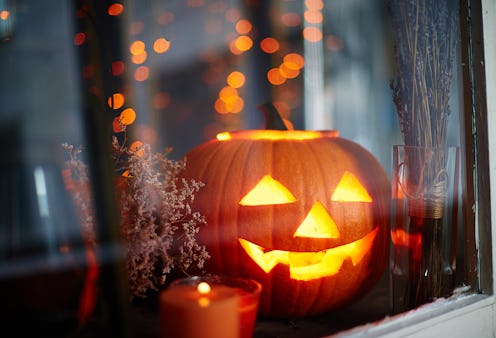Life
Why Halloween Is Always Celebrated On October 31

There are holidays that always fall on a certain day of the week rather than a date: The first Monday of the month, for instance, or the last Thursday of the month. Memorial Day, Thanksgiving, Labor Day — they're all great examples of this. Halloween is not one of those holidays, though. Instead, every year this holiday is celebrated exactly on Oct. 31, without fail. But, why? Well, turns out there are specific, centuries-old reasons why Halloween is celebrated on the Oct. 31 every year. It has nothing to do with candy sales, or marketing campaigns around Halloween costumes, because despite the outrageous amount of money we spend on both every year, Halloween has a fascinating history that dates back to the eighth century.
Even though it's a highly celebrated holiday that requires planning, parties, and costumes, and also has deep religious roots, Halloween is not a holiday that garners a day off work. Once we get a sequel to Hocus Pocus , perhaps? Fingers crossed. That said, it's still a deeply important holiday, historically, and his rich roots dating back centuries.
No matter when you choose to celebrate the actual holiday — the month prior to, weekend before, or the day of — Halloween is just the first major holiday in the actual holiday season. Once the fake skeletons are packed away and the candy corn is thrown away on Nov, 1, you'll need to bust out the red and green decor for the fast approaching Christmas season. So, enjoy every second of Halloween while you can. Here's why Halloween is celebrated on Oct. 31.
Because, Ghosts
Halloween originated from the ancient Celtic festival known as Samhain — which is pronounced "sow-in." The celebration always took place at the end of October to honor the end of the harvest, and the start of the new year. During this time, the Celts believed the barrier between the living and the dead was at its thinnest, so it was considered possible to communicate with the deceased.
All Saints' Day
In the eighth century, Pope Gregory III declared Nov. 1 as All Saints' Day. This was a time to pay tribute to all saints and martyrs. It incorporated some of the same traditions as the original Samhain festival, and the night before All Saints' Day became known as All Hallows' Eve.
Thank The Irish And The Scots
Before emigrating to America, the Irish used carved out turnips with demon faces to frighten spirits away. After settling in America, Irish immigrants in the 1840s found turnips to be scarce, and started using pumpkins instead. As a result, Irish and Scottish immigrants are responsible for bringing the Oct. 31 tradition of All Hallows' Eve (aka Halloween) to America — so we all need to send out a silent thank you to our Irish and Scottish ancestors for this spooky and wonderful gift.
Image: Pressmaster/Shutterstock; Giphy (4)